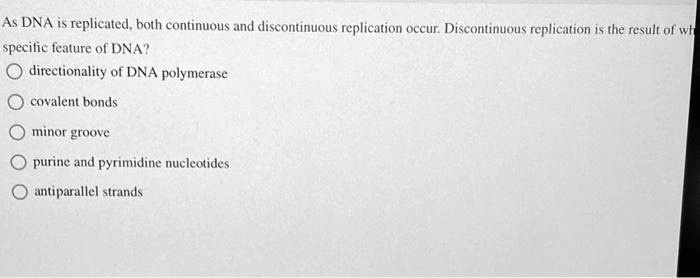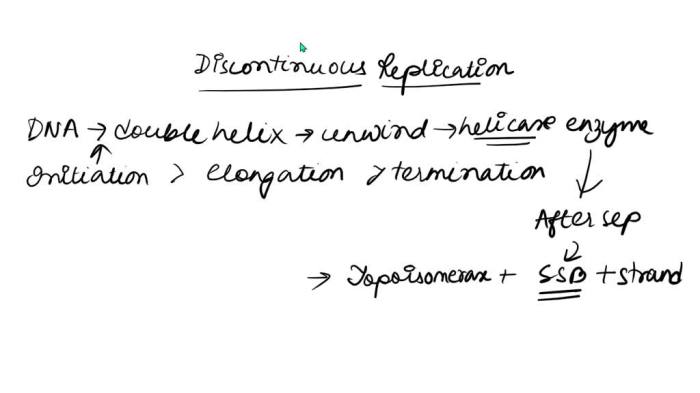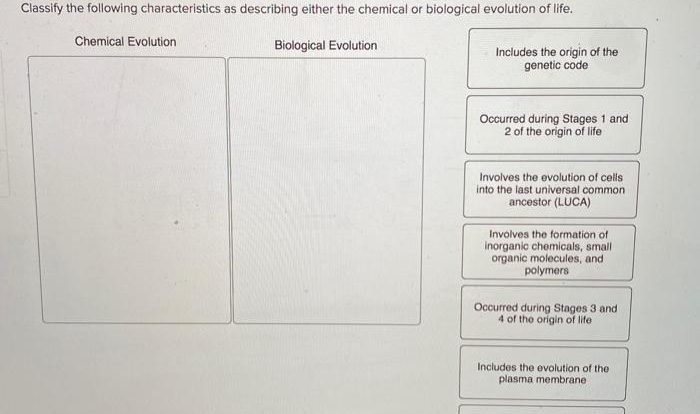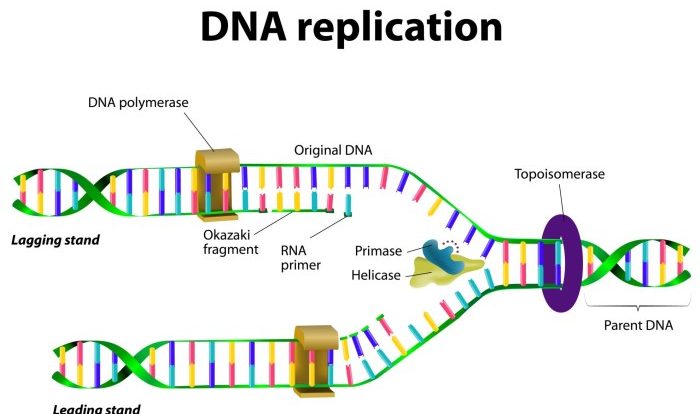As dna is replicated both continuous and discontinuous – As DNA is replicated, a captivating tale unfolds, revealing the intricate interplay between continuous and discontinuous synthesis. This process, essential for life, unveils the secrets of genetic inheritance and the preservation of our genetic blueprint.
DNA replication, a symphony of molecular precision, ensures the faithful transmission of genetic information from one generation to the next. As the double helix unwinds, a molecular dance ensues, with enzymes and proteins orchestrating the synthesis of new DNA strands.
Amidst this molecular ballet, a fundamental distinction emerges: the leading strand, where synthesis proceeds continuously, and the lagging strand, where discontinuous replication takes center stage.
DNA Replication Process

DNA replication is the process by which DNA makes a copy of itself. It is essential for cell division and growth, and it ensures that each new cell has a complete copy of the genetic material.
The DNA replication process is carried out by a large number of enzymes and proteins. The main enzymes involved in DNA replication are DNA polymerase, helicase, and ligase.
DNA polymerase is the enzyme that adds nucleotides to the growing DNA strand. Helicase is the enzyme that unwinds the DNA double helix, and ligase is the enzyme that joins the newly synthesized DNA strands together.
The DNA replication process begins when helicase unwinds the DNA double helix. This creates a replication bubble, which is a region of DNA that is not double-stranded. DNA polymerase then binds to the single-stranded DNA and begins to add nucleotides to the growing DNA strand.
As DNA polymerase adds nucleotides to the growing DNA strand, it also proofreads the newly synthesized DNA. If DNA polymerase finds an error, it will remove the incorrect nucleotide and replace it with the correct nucleotide.
Once DNA polymerase has reached the end of the DNA template, it will release the newly synthesized DNA strand. Ligase then joins the newly synthesized DNA strand to the existing DNA strand, completing the DNA replication process.
Differences Between Leading and Lagging Strands
The DNA replication process is continuous on the leading strand. This means that DNA polymerase can add nucleotides to the growing DNA strand in a continuous manner.
However, the DNA replication process is discontinuous on the lagging strand. This is because the DNA double helix is antiparallel, which means that the two strands run in opposite directions.
As a result, DNA polymerase can only add nucleotides to the growing DNA strand in the 5′ to 3′ direction. This means that DNA polymerase must synthesize the lagging strand in short fragments, called Okazaki fragments.
Okazaki fragments are then joined together by ligase to form a continuous DNA strand.
Continuous and Discontinuous Replication

Continuous Replication on the Leading Strand
Continuous replication occurs on the leading strand because DNA polymerase can add nucleotides to the growing DNA strand in a continuous manner.
The leading strand is the strand that is synthesized in the same direction as the unwinding of the DNA double helix.
Discontinuous Replication on the Lagging Strand
Discontinuous replication occurs on the lagging strand because DNA polymerase can only add nucleotides to the growing DNA strand in the 5′ to 3′ direction.
The lagging strand is the strand that is synthesized in the opposite direction as the unwinding of the DNA double helix.
As a result, DNA polymerase must synthesize the lagging strand in short fragments, called Okazaki fragments.
Okazaki fragments are then joined together by ligase to form a continuous DNA strand.
Priming and Fragment Joining

Role of RNA Primers in Initiating DNA Synthesis
RNA primers are short RNA molecules that are synthesized by primase.
RNA primers are complementary to the template strand of DNA, and they provide a free 3′ hydroxyl group for DNA polymerase to add nucleotides to.
Once DNA polymerase has added a few nucleotides to the growing DNA strand, it will displace the RNA primer and continue to synthesize the DNA strand in a continuous manner.
How DNA Polymerase Adds Nucleotides to the Growing DNA Strand
DNA polymerase adds nucleotides to the growing DNA strand in a 5′ to 3′ direction.
DNA polymerase uses the template strand of DNA to determine which nucleotide to add to the growing DNA strand.
DNA polymerase also proofreads the newly synthesized DNA strand, and it will remove any incorrect nucleotides.
Process of Joining Okazaki Fragments on the Lagging Strand
Okazaki fragments are joined together by ligase.
Ligase is an enzyme that catalyzes the formation of phosphodiester bonds between adjacent nucleotides.
Ligase joins the 3′ hydroxyl group of one Okazaki fragment to the 5′ phosphate group of the next Okazaki fragment.
Replication Errors and Repair: As Dna Is Replicated Both Continuous And Discontinuous

Types of Errors that Can Occur During DNA Replication
There are several types of errors that can occur during DNA replication.
- Base substitution errors: These errors occur when one nucleotide is replaced by another nucleotide.
- Insertion errors: These errors occur when an extra nucleotide is inserted into the DNA strand.
- Deletion errors: These errors occur when a nucleotide is deleted from the DNA strand.
How DNA Repair Mechanisms Correct These Errors
DNA repair mechanisms are cellular processes that correct errors that occur during DNA replication.
There are several different DNA repair mechanisms, including:
- Base excision repair: This mechanism repairs base substitution errors.
- Nucleotide excision repair: This mechanism repairs insertion and deletion errors.
- Mismatch repair: This mechanism repairs base substitution errors that occur during DNA replication.
Importance of DNA Repair for Maintaining Genetic Integrity
DNA repair mechanisms are essential for maintaining genetic integrity.
If DNA repair mechanisms did not exist, errors that occur during DNA replication would accumulate over time.
This would lead to mutations, which could have a negative impact on the cell or organism.
Applications of DNA Replication
Applications of DNA Replication in Biotechnology
DNA replication is used in a variety of biotechnology applications, including:
- Polymerase chain reaction (PCR): PCR is a technique that is used to amplify a specific region of DNA.
- DNA sequencing: DNA sequencing is a technique that is used to determine the order of nucleotides in a DNA molecule.
Applications of DNA Replication in Forensic Science and Medicine
DNA replication is also used in a variety of forensic science and medical applications, including:
- DNA fingerprinting: DNA fingerprinting is a technique that is used to identify individuals based on their DNA.
- Prenatal diagnosis: Prenatal diagnosis is a technique that is used to identify genetic disorders in unborn children.
Potential Implications of DNA Replication Research for Future Technologies, As dna is replicated both continuous and discontinuous
DNA replication research has the potential to lead to the development of new technologies, including:
- Gene therapy: Gene therapy is a technique that is used to treat genetic disorders by introducing a functional gene into a patient’s cells.
- Synthetic biology: Synthetic biology is a field that is focused on the design and construction of new biological systems.
Expert Answers
What is the difference between leading and lagging strands in DNA replication?
The leading strand is synthesized continuously in the 5′ to 3′ direction, following the unwinding of the DNA double helix. The lagging strand, on the other hand, is synthesized discontinuously in short fragments called Okazaki fragments, which are later joined together.
What is the role of RNA primers in DNA replication?
RNA primers are short RNA molecules that provide a starting point for DNA polymerase to initiate DNA synthesis. Once the DNA strand is extended, the RNA primer is removed and replaced with DNA.
How are Okazaki fragments joined together?
Okazaki fragments are joined together by an enzyme called DNA ligase. DNA ligase covalently bonds the 3′ hydroxyl group of one fragment to the 5′ phosphate group of the adjacent fragment, creating a continuous DNA strand.

